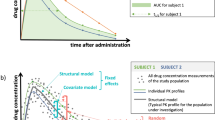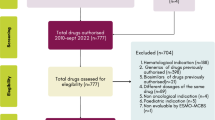Abstract
Background and Objective
Pazopanib is an oral tyrosine kinase inhibitor used in the treatment of renal cell carcinoma and soft-tissue sarcoma. At the approved dose of 800 mg once daily (QD), 16–20% of patients are being underdosed and at risk of decreased efficacy. This study aimed to show whether splitting intake moments, as a cost-neutral alternative to a dose increase, leads to an increased exposure.
Methods
We performed a cross-over trial comparing the pharmacokinetics of pazopanib 800 mg QD with pazopanib 400 mg twice daily. Pharmacokinetic sampling was performed at steady-state for both dosing schedules.
Results
Nine evaluable patients were included. At the 800 mg QD dosing schedule, median minimum plasma concentration (Cmin), area under the concentration–time curve from 0 to 24 h (AUC0–24h), and maximum plasma concentration (Cmax) were 23.2 mg/L (interquartile range 18.5–27.6), 773 mg h/L (557–1009), and 40.6 mg/L (36.4–56.4) compared with 41.6 mg/L (30.5–55.8, p = 0.004), 942 mg h/L (885–1419, p = 0.027), and 50.2 mg/L (46.8–72.5, p = 0.074) at 400 mg twice daily. One patient experienced a grade 3 event (i.e., diarrhea).
Conclusions
This study demonstrates that splitting intake moments of pazopanib leads to a 79% increase in Cmin, with acceptable tolerability. Therefore, this new dosing schedule offers a cost-neutral opportunity to optimize treatment in patients with low exposure.
Clinical Trial Registration
NL6137 (http://www.trialregister.nl).



Similar content being viewed by others
References
Summary of product characteristics of pazopanib. http://www.ema.europa.eu/docs/nl_NL/document_library/EPAR_-_Product_Information/human/001141/WC500094272.pdf. Accessed 14 Jan 2020.
Sternberg CN, Davis ID, Mardiak J, Szczylik C, Lee E, Wagstaff J, et al. Pazopanib in locally advanced or metastatic renal cell carcinoma: results of a randomized phase III trial. J Clin Oncol. 2010;28:1061–8.
Suttle AB, Ball H, Molimard M, Hutson T, Carpenter C, Rajagopalan D, et al. Relationships between pazopanib exposure and clinical safety and efficacy in patients with advanced renal cell carcinoma. Br J Cancer. 2014;111:1–8.
Sternberg CN, Donskov F, Haas NB, Doehn C, Russo P, Elmeliegy M, et al. Pazopanib exposure relationship with clinical efficacy and safety in the adjuvant treatment of advanced renal cell carcinoma. Clin Cancer Res. 2018;24:3005–13.
Verheijen RB, Swart LE, Beijnen JH, Schellens JHM, Huitema ADR, Steeghs N. Exposure-survival analyses of pazopanib in renal cell carcinoma and soft tissue sarcoma patients: opportunities for dose optimization. Cancer Chemother Pharmacol. 2017;80:1171–8.
Hurwitz HI, Dowlati A, Saini S, Savage S, Suttle AB, Gibson DM, et al. Phase I trial of pazopanib in patients with advanced cancer. Clin Cancer Res. 2009;15:4220–7.
Lubberman FJE, Gelderblom H, Hamberg P, Vervenne WL, Mulder SF, Jansman FGA, et al. The effect of using pazopanib with food vs fasted on pharmacokinetics, patient safety and preference (DIET study). Clin Pharmacol Ther. 2019;106:1076–82.
Groenland SL, van Eerden RAG, Verheijen RB, Koolen SLW, Moes DJAR, Desar IME, et al. Therapeutic drug monitoring of oral anticancer drugs: the DPOG-TDM protocol for a prospective study. Ther Drug Monit. 2019;41:561–7.
Verheijen RB, Bins S, Mathijssen RHJ, Lolkema MP, van Doorn L, Schellens JHM, et al. Individualized pazopanib dosing: a prospective feasibility study in cancer patients. Clin Cancer Res. 2016;22:5738–46.
Yu H, van Erp N, Bins S, Mathijssen RHJ, Schellens JHM, Beijnen JH, et al. Development of a pharmacokinetic model to describe the complex pharmacokinetics of pazopanib in cancer patients. Clin Pharmacokinet. 2017;56:293–303.
Wang Y, Chia Y, Nedelman J, Schran H, Mahon F, Molimard M. A therapeutic drug monitoring algorithm for refining the imatinib trough level obtained at different sampling times. Ther Drug Monit. 2009;31:579–84.
Herbrink M, De Vries N, Rosing H, Huitema ADR, Nuijen B, Schellens JHM, et al. Quantification of 11 therapeutic kinase inhibitors in human plasma for therapeutic drug monitoring using liquid chromatography coupled with tandem mass spectrometry. Ther Drug Monit. 2016;38:649–56.
R Core Development Team. A language and environment for statistical computing. R Found Statistical Computing, Vienna. 2016. https://www.r-project.org/. Accessed 14 Jan 2020.
van Leeuwen R, van Gelder T, Mathijssen R, Jansman F. Drug-drug interactions with tyrosine-kinase inhibitors: a clinical perspective. Lancet Oncol. 2014;15:e315–26.
Deng Y, Sychterz C, Suttle AB, Dar MM, Bershas D, Negash K, et al. Bioavailability, metabolism and disposition of oral pazopanib in patients with advanced cancer. Xenobiotica. 2013;43:443–53.
Herbrink M, Groenland SL, Huitema ADR, Schellens JHM, Beijnen JH, Steeghs N, et al. Solubility and bioavailability improvement of pazopanib hydrochloride. Int J Pharm. 2018;544:181–90.
Hellriegel ET, Bjornsson TD, Hauck WW. Interpatient variability in bioavailability is related to the extent of absorption: implications for bioavailability and bioequivalence studies. Clin Pharmacol Ther. 1996;60:601–7.
de Wit D, Van Erp NP, den Hartigh J, Wolterbeek R, Deursen MDH, Labots M, et al. Therapeutic drug monitoring to individualize the dosing of pazopanib: a pharmacokinetic feasibility study. Ther Drug Monit. 2015;37:331–8.
Lankheet N, Desar I, Mulder S, Burger D, Kweekel D, van Herpen CML, et al. Optimizing the dose in cancer patients treated with imatinib, sunitinib and pazopanib. Br J Clin Pharmacol. 2017;83:2195–204.
Heath EI, Chiorean EG, Sweeney CJ, Hodge JP, Lager JJ, Forman K, et al. A phase I study of the pharmacokinetic and safety profiles of oral pazopanib with a high-fat or low-fat meal in patients with advanced solid tumors. Clin Pharmacol Ther. 2010;88:818–23.
Groenland S, van Eerden R, Koolen S, Moes D, Desar I, Touw D, et al. Therapeutic drug monitoring of oral anticancer drugs: preliminary results of a prospective study. Ann Oncol. 2019;30:v159–93.
Acknowledgements
We thank all patients for their participation in this study. We thank Dr. Huixin Yu for performing the simulations. In addition, we thank the study team for their contribution, in particular Else Meijer and Brigitte Dufourny. This work was presented in part at the 2019 American Society of Clinical Oncology Annual Meeting, Chicago, IL, USA (J Clin Oncol. 2019;37 Suppl.:abstract 3119).
Author information
Authors and Affiliations
Consortia
Corresponding author
Ethics declarations
Funding
No funding has been received for the conduct of this study of the preparation of this article.
Conflict of interest
Remy B. Verheijen is currently an employee and shareholder of AstraZeneca, Cambridge, UK. Stijn L.W. Koolen and Ron H.J. Mathijssen received funding and speakers’ fees by Novartis on a topic not related to the current study. Jos H. Beijnen is a part-time employee, stock holder, and patent holder of Modra Pharmaceuticals (a spin-out company developing oral taxane formulations, not related to this study). Stefanie L. Groenland, Ruben A.G. van Eerden, Niels de Vries, Bas Thijssen, Hilde Rosing, Alwin D.R. Huitema, and Neeltje Steeghs have no conflicts of interest that are directly relevant to the content of this article.
Ethics approval
All procedures performed in studies involving human participants were in accordance with the ethical standards of the institutional research committee (Medical Ethics Committee of The Netherlands Cancer Institute-Antoni van Leeuwenhoek, reference number: METC17.482/N17PSI) and with the 1964 Helsinki Declaration and its later amendments or comparable ethical standards.
Consent to participate
Informed consent was obtained from all individual participants included in the study.
Data availability
The datasets generated during and/or analyzed during the current study are available from the corresponding author on reasonable request.
Rights and permissions
About this article
Cite this article
Groenland, S.L., van Eerden, R.A.G., Verheijen, R.B. et al. Cost-Neutral Optimization of Pazopanib Exposure by Splitting Intake Moments: A Prospective Pharmacokinetic Study in Cancer Patients. Clin Pharmacokinet 59, 941–948 (2020). https://doi.org/10.1007/s40262-020-00863-5
Published:
Issue Date:
DOI: https://doi.org/10.1007/s40262-020-00863-5




